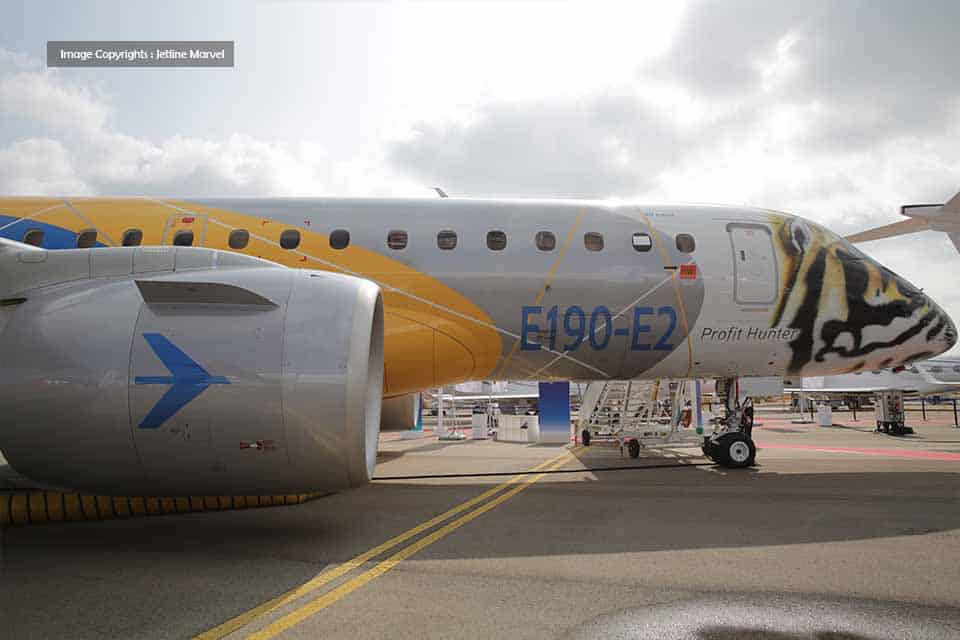Aerospace
Embraer E190-E2 Granted Type Certification in China
Embraer E190-E2 Granted Type Certification in China

Zhuhai, China, November 10, 2022 – The Embraer E190-E2 has been granted its Type Certificate by the Civil Aviation Administration of China (CAAC), marking the start of exciting times ahead for Embraer’s E2 program in China. It is expected that certification for Embraer’s larger E195-E2 aircraft, which is ongoing, will follow shortly.
“CAAC’s certification of the E190-E2 is great news for Embraer and our prospective customers in China,” said Arjan Meijer, President, and CEO of Embraer Commercial Aviation. “Certification paves the way for significant E190-E2 business opportunities in China – data reveals that one billion people living in China’s second and third tier cities have never taken a flight.”
Meijer added, “The E190-E2 and E195-E2, seating up to 114 and 146 passengers respectively, offer the complementary capacity to China’s indigenous ARJ21 and C919 aircraft. The E2 will not only provide the best in class economics and emission reductions for airlines, but also help to accelerate the implementation of China’s Essential Air Service program to connect more secondary and tertiary cities.”
Embraer latest market forecast revealed that 1445 new aircraft in the up to 150-seat category will be delivered in China through 2041; driven by the nation’s long-term economic development, and the continuing trend of the Chinese civil aviation system evolving from point-to-point to a more hub-and-spoke based network.
Embraer’s E2 family of aircraft enables airlines to build operational flexibility, match capacity with demand, and add frequencies, enhancing connectivity in China in the post epidemic era. E190-E2 and E195-E2 are the most fuel-efficient single aisle aircraft flying today, delivering 17.3% and 25.4% better fuel efficiency per seat respectively, compared to previous generation E-Jets.
“It’s a big moment for our newest generation Embraer jet – the E190-E2 – to be certified by CAAC,” said Guo Qing, Managing Director and VP Commercial Aviation, Embraer China. “Besides its right-size and fuel efficiency, the E190-E2 was born with superior hot-and-high capability. It’s the first aircraft in its class to have flown to some of the world highest airports in western China including Lasha and Yushu. We believe the E190-E2 is the best aircraft to serve low density but high elevation markets in western China with the right performance, more profitability.”
The E190-E2 first began service in Europe in 2018. It is a single aisle jet with a capacity of up to 114 seats in Embraer’s signature two by two seating. Featuring the latest technology yet building on the maturity and reliability of the first-generation E-Jets, the aircraft delivers the lowest operating costs for airlines and outstanding performance that enables access to airports that have restrictions due to higher altitude or shorter runways. The aircraft is also designed for greater passenger comfort with more space for bags, has the smallest noise footprint and lowest emissions

Aerospace
Boeing Transfers Rocket Stage to NASA, Paving Way for Human Moon Mission

Boeing has achieved a significant milestone by providing NASA with the second core stage of the Space Launch System (SLS) rocket.
This crucial component, crafted at NASA’s Michoud Assembly Facility (MAF), is set to propel the Artemis II crew into lunar orbit, marking humanity’s return to deep space after a 50-year hiatus.
The monumental Boeing-built rocket stage, the largest element of the Artemis II mission, will embark on a journey aboard the Pegasus barge, traveling 900 miles to NASA’s Kennedy Space Center.
Comparison of two legendary aircraft B777x vs B747 aircraft:Click here
Upon arrival, it will be meticulously integrated with other essential Artemis II components, including the upper stage, solid rocket boosters, and NASA’s Orion spacecraft within the iconic Vehicle Assembly Building. This intricate integration process is a vital step toward the eagerly anticipated Artemis II launch, slated for 2025.
“Boeing-built products helped land humankind on the moon in 1969, and we’re proud to continue that legacy through the Artemis generation,” remarked Dave Dutcher, vice president and program manager for Boeing’s SLS program. “Together, with NASA and our industry partners and suppliers, we are building the world’s most capable rocket and paving the way to deep space through America’s rocket factory in New Orleans.”
NASA, Lockheed Martin Reveal X-59 Quiet Supersonic Aircraft:Click here
The delivery of Core Stage 2 marks a significant achievement in the evolution of the SLS rocket. Towering over 200 feet and powered by four RS-25 engines, this core stage, coupled with two solid-fueled booster rockets, will generate a staggering 8.8 million pounds of thrust. This immense power is crucial to launching Artemis II and future missions into the vast expanse of space.
The SLS rocket stands unparalleled in its capability to transport both crew and substantial cargo to the moon and beyond in a single launch. Its extraordinary capacity will facilitate the delivery of human-rated spacecraft, habitats, and scientific missions to destinations including the moon and Mars, ushering in a new era of space exploration.
-

 Travel1 week ago
Travel1 week agoAir India to Expand US Operations with Three New Routes After a Decade
-

 Travel2 weeks ago
Travel2 weeks agoWhy We Should Avoid These Stamps in a Passport
-

 Airlines1 month ago
Airlines1 month agoInvestigations Reveal Fake Chinese Titanium in Boeing and Airbus Jets
-

 Tech4 weeks ago
Tech4 weeks agoChina’s CATL Plans 1,800-Mile Electric Plane Launch by 2027
-

 Airport3 days ago
Airport3 days agoTop 10 Largest Airports in the World by Size
-

 Aerospace4 weeks ago
Aerospace4 weeks agoChina’s Fighter Jets Turn Wings into Autonomous Drones
-

 Airlines4 days ago
Airlines4 days agoAir India Rolls Out A350s for Delhi-New York JFK and Newark Routes
-

 Defence3 weeks ago
Defence3 weeks agoBoeing Enhances Chinook with New Engines and Block II Upgrades at $96 Million







